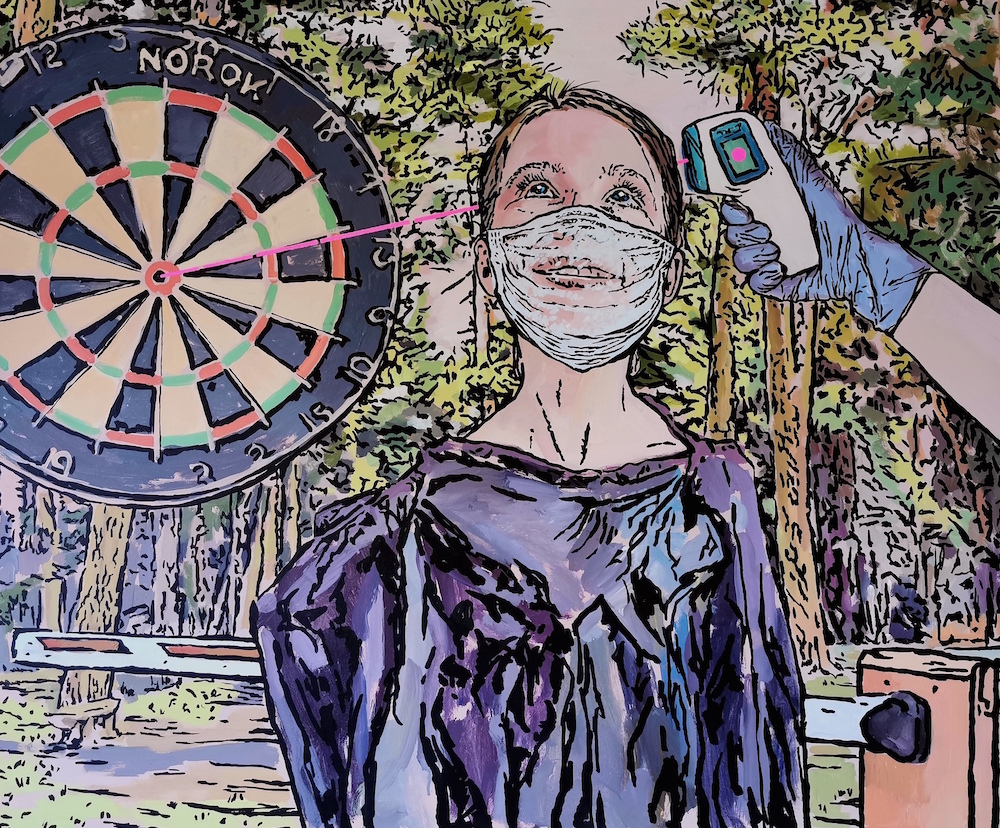Camouflage is J. Kyzikaitė’s ninth exhibition, a project financed by the Lithuanian Council for Culture. According to art critic Deima Žuklytė-Gasperaitienė, the artist’s manner of painting is generalizing and poster-like. A decorative effect is created by the use of a bright contour line that defines objects and subjects. She doesn’t try to avoid kitschy colors and textures, thus “rendering harmless” the uncomfortable or threatening subjects of works, bringing them closer to images wandering in the media and easy for the audience to consume.
Painter Jolanta Kyzikaitė is a Doctor of Art, her work has been presented in more than 60 joint exhibitions in Lithuania and abroad. In 2010, Jolanta Kyzikaitė became the first-place winner in the Young Painter’s Prize competition. Gallery Meno Niša has been working with J. Kyzikaitė for 10 years – during this time, the painter has been presented at art fairs in Vilnius, Budapest, Cologne, Berlin, Moscow, Paris, Brussels, and Vienna. Jolanta Kyzikaitė’s works have been acquired by the MO Museum, the Lewben Art Foundation, the Walter Bischoff Gallery in Germany, and private collectors.
In the short interview, J. Kyzikaitė told about the idea of her latest exhibition Camouflage, the symbolism of masks, and her plans for the future.

Jolanta Kyzikatė. Gallery Meno Nisa archives
Jolanta, you examined the relevance of masks in art even before the pandemic, in your project Painting at Play, which was your doctoral work. Now you are continuing this topic. Why?
Masks not only hide but, at the same time, reveal, because under the mask, a person feels safer, often showing those personality traits that were hidden before. Also, in the historical and cultural context, the image of the mask has always been relevant. Let us remember masquerades, carnivals, Užgavėnės (Mardi Gras), which have had a mystical meaning since ancient times. Masks have always hidden some sort of secret and have always appeared in the works of artists. My work is no exception, I have long been interested in the topic of masks. However, it is not necessary to depict masks in painting to reveal relationships. I am interested in the situation itself – how physical withdrawal from the public (be it by wearing a mask or by self-isolation) affects relations with people and the environment around us. By examining the present, I try to see the future. I am interested in the word ‘beyond’, it refers not only to a certain place (beyond the wall, beyond the mask) but also to time (beyond quarantine, beyond the financial crisis). The relationship between space and time has become more important than ever.
How has your own withdrawal from the public, by wearing a mask, affected you as a person and as an artist?
An artist is a loner anyway, and a painter in particular. When we work, we spend a lot of time alone in the studio. So, isolation may have affected me more because not only are you isolated, but your loved ones are isolated together. Then there’s a kind of internal resistance because you want to spend more time with your loved ones at home than working in the studio.
I’ve been left with this ambiguous question – are you isolated from everyone because you paint, or are you spending more time with your loved ones because they are also self-isolating at home. Personally, I managed to do more before quarantine, because everyone went to work, and I went to my studio, where isolation happens naturally. The amount of time we, painters, spend in public is very short compared to how much of it we spend in the studio.
And mask-wearing itself did not affect me much, because for me there are hardly any places where I’d need to wear the mask (we live in a private house in the suburbs). I only put on the mask when I was teaching painting in my studio, and also when going to the store. I spend the rest of my time in the studio alone.
The exhibition will also feature your drawing cycle Image Diary. Tell us more about these works, why they were drawn on Soviet instructional drawings and other documents?
All those old documents were found in my painting studio, which is not modern, has remained as it was built many years ago. That is why images are created on this kind of paper – it is my every-day life. Think about how much paper I save when I resurrect old unneeded documents for a new life? This way, I try to capture my daily observations on paper, it becomes like a diary, only not written, but drawn.
What are your other creative plans for this year?
A few weeks ago, my drawing cycle was presented at the Gallery Meno Niša in Germany at the Positions Berlin Art Fair, and next week I will be participating in the ArtVilnius’20 Contemporary Art Fair with the gallery. As an extension of the exhibition, part of the works of the large-format exhibition Camouflage will be shown there. This year, I will also participate in a mobile exhibition, where my works will be presented in smaller towns for those who do not have the opportunity to visit exhibitions in Vilnius.
Thank you for the conversation!
Jolanta Kyzikaitė’s exhibition Camouflage in Gallery Meno Niša will be shown from September 25 to October 23. The gallery is open II-V 12 p.m.-6 p.m. and VI 12 p.m.-4 p.m.
The exhibition is financed by the Lithuanian Council for Culture and Vilnius City Municipality.
Gallery name: Meno niša Gallery
Address: J. Basanavičiaus g. 1/13, Vilnius
Opening hours: Tue-Fri 12:00 - 18:00, Sat 12:00 - 16:00
Open: 25.09.2020 - 23.10.2020







